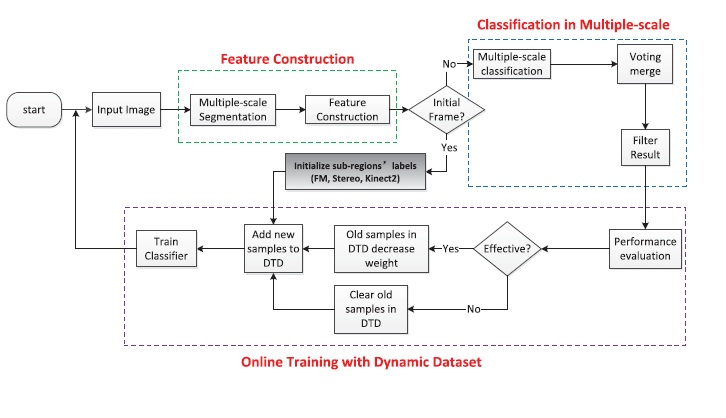- ALL COMPUTER, ELECTRONICS AND MECHANICAL COURSES AVAILABLE…. PROJECT GUIDANCE SINCE 2004. FOR FURTHER DETAILS CALL 9443117328


Projects > ELECTRONICS > 2017 > IEEE > DIGITAL IMAGE PROCESSING
In this paper, we present an online learning framework for traversable region detection fusing both appearance and geometry information. Our framework proposes an appearance classifier supervised by the sparse geometric clues to capture the variation in online data, yielding dense detection result in real time. It provides superior detection performance using appearance information with weak geometric prior and can be further improved with more geometry from external sensors. The learning process is divided into three steps: First, we construct features from the super-pixel level, which reduces the computational cost compared with the pixel level processing. Then we classify the multi-scale super-pixels to vote the label of each pixel. Second, we use weighted extreme learning machine as our classifier to deal with the imbalanced data distribution since the weak geometric prior only initializes the labels in a small region. Finally, we employ the online learning process so that our framework can be adaptive to the changing scenes.
Support Vector Machine (SVM), Fuzzy SVM.
This paper presents a novel and scalable travelable region detection framework fusing with both appearance and geometrical information, our approach can be insensitive to challenging environments with varied lightings, shadows, blurred images and dynamic objects. We also carried out quantitative experiments to evaluate our approach with state-of-the-art methods and proved that our approach can achieve superior performances on both adaptability and stableness in real traversable region detection. As our approach only uses a weak assumed model of the traversable and impassible regions, which can be satisfied in most conditions, the model’s universality of our method can be guaranteed. The found mask introduced in our approach can be also reinforced by the geometrical information, which will further improve the performance of our method. In additional, the online learning framework in our approach can update the internal parameters of our method and make the parameters adaptive (or robust) to the changes of scenes or illuminations.
BLOCK DIAGRAM
